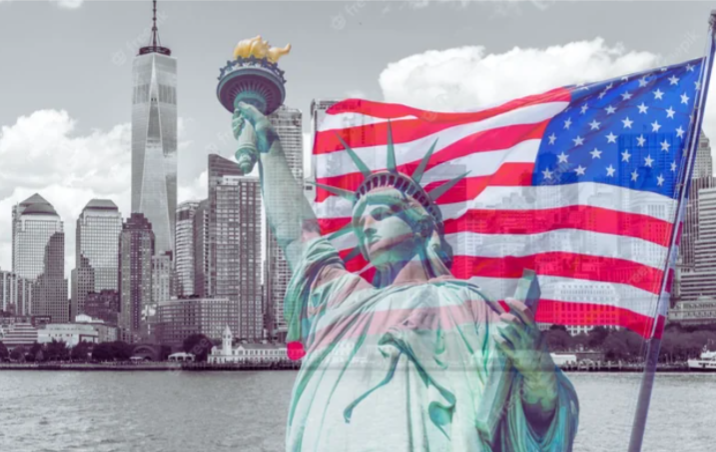(ThyBlackMan.com) America’s business elites have used immigration as a tool to avoid hiring Black Americans for the past two centuries. This pattern of discrimination has depressed African Americans’ employment and wages — and is a significant cause of persistent racial wealth gaps.

The trend began even before the Civil War. By the early 1800s, many Northern states had banned slavery and were home to substantial numbers of free Black workers. But starting in the 1820s, northern employers increasingly sought cheaper white immigrant workers from Europe — which stalled Black economic momentum.
After the Civil War and emancipation, former slaves began migrating to northern states to staff the factories of a rapidly industrializing nation. This led to huge jumps in African American skills, incomes, and even business ownership.
Southern plantations and businesses despaired of their dwindling source of cheap labor. But by the 1880s, they were rescued by the grand political and economic bargaining that ended Reconstruction in the South and resulted in the Ellis Island-era “Great Wave of Immigration.” Each year over the next four decades, an average of nearly 600,000 immigrants — roughly 1% of the total U.S. population — flowed primarily into northern labor markets. That largely blocked the flow of Black workers from the South. In fact, many former slaves and their families moved back to the lower-wage South after they were displaced by desperate immigrants willing to accept low wages and appalling working conditions.
In this way, mass immigration solved not just northern economic elites’ “worker shortage” problem, but southern elites’ too. By 1910, about 90% of all African Americans were still laboring as farm workers and household servants in the South, primarily on or near the southern plantations where they or their ancestors had been enslaved.
Finally, in 1924, public pressure — including from notable Black leaders of the day like A. Philip Randolph and W. E. B. Du Bois — forced Congress to drastically reduce annual immigration.
The ensuing tightness in northern labor markets created a huge demand for underemployed, underpaid southern workers. Some six million African Americans left the South during the Great Migration made possible by tighter labor markets. By the 1960s, the share of Black households that were considered middle class had expanded from two in 10 to seven in 10. African Americans’ greatly increased economic clout was an important factor in Congress passing the Civil Rights and Voting Rights Acts of 1964 and 1965.
But the economic boom didn’t last. Congress reopened mass migration in the 1960s, and — just as before — economic progress ceased for most Black Americans.
In response, federal commissions in the 1970s called on Congress to reduce the immigration numbers, but lawmakers instead heeded the concerns of employer lobbies that expressed fears of “worker shortages.”
In 1989, another federally commissioned study found that the nation’s declining birth rates would tighten labor markets and likely lead to more Black Americans being pulled into the workforce.
Predictably, business lobbies warned of a “worker shortage” — and once again convinced lawmakers to import even more foreign laborers. Instead of viewing tight job markets as an opportunity to bring more disadvantaged Black Americans into the workforce and close racial wealth gaps, Congress chose to enable businesses to fill the open jobs with foreign workers.
In the decades since, the U.S. government has offered lifetime work authorization to more than 30 million immigrants, not counting millions of foreign workers who have entered the country illegally.
The United States doesn’t have a worker shortage. For example, approximately four in 10 working-age African Americans with only high school diplomas don’t have jobs. Many would jump at the chance to work, if recruited at fair wages and working conditions.
It’s not difficult to see racial bias behind the worker shortage narrative. According to anthropologists like Angela Stuesse, many Black workers recognize that the term “labor shortage” has discriminatory undertones. In her words, it’s “shorthand” for businesses not wanting to employ African Americans or “adjust working conditions and wages to retain employees.”
For two centuries, the labor shortage myth has been used to justify immigration policies that disadvantage Black Americans. Today, the median household wealth of descendants of American slavery remains much less than that of recent immigrants — and less than 15% that of the descendants of European immigrants and settlers.
Given our history, claims of a “worker shortage” should put any racially sensitive American on high alert.
Written by Roy Beck
Official website; https://backofthehiringline.com/
















Immigration does not undermine economic progress. There are two things that undermine economic power.Those things are (1) Lack of education; and (2)Failure to understand that politically,America is a pluralistic representative democracy with a capitalist economic base that believes in an unequal distribution of available goods and services based on merit. Merit is defined as usefulness to the republic.Selecting a vocation in America should be one that is useful,and subsequently profitable to you.
Could not Agree with You More in Regard to the Facts of Your Article.
Your article stitched together with my articles regarding undercounting our unemployment rates paints a picture of manipulation to make it appear we have a labor shortage. It’s the Democratic Party through Clinton, Obama, and Biden who conjured up the scheme of undercounting our Job rates to make it appear we have a labor shortage and sold that lie to America. So, we as a people are in a fix as we have those who look like us at the highest levels of government working hand and hand with many on the other side against us.
Just as Republican legislators across the spectrum from Senators to members of the House of Representatives are unable to find the courage to speak out against the vulgarism of former president Donald Trump, fearing repercussions, African American legislators, and Civil Rights leaders fear the power of the Biden-Harris White House, and his administration. Their silence is deafening, when it comes to the issue of undercounting the unemployment rates of American workers, which is devastating to the African American community. They are strongly encouraged not to publicly address this wrong if they want to keep their jobs or have a political future.
Black American representation in legislatures and mayoral leadership are at an all-time high. There are a record 62 Black members serving in Congress, with Rep. Akeem Jeffries, of New York, serving as the Minority Leader of the Democratic Party in the House of Representatives. Black mayors head the cities of Chicago, New York, Philadelphia, Los Angeles, and Atlanta. There is even a black Civil Rights leader in the person of Reverend Al Sharpton who regularly appears on the popular “Morning Joe program on MSNBC.” Of what use is their power, if they do not use that power, to correct the unjust policy of the Biden-Harris administration, when it comes to undercounting the Job rates of American workers, including African American workers. The Truth, about their lack of courage, when it comes to this issue is heartbreaking, and hard for many of us to digest, and understand. When it comes to their integrity, let’s hope the story doesn’t end here.
Historically, African Americans have voted overwhelmingly Democratic since the days of Franklin D. Roosevelt. Black voters saved Joe Biden’s last disastrous presidential run for office. Biden was losing the Democratic Party’s primary in 2020 and black voters changed that narrative, making him a winner. Now, this guy is kicking African Americans in the teeth by undercounting our Job rates and the Job rates of all American workers, professional, union, blue collar, and working-class Americans, everywhere. Biden lies about our unemployment rates saying his official rate is comprehensive. Read the article at the link:
https://thyblackman.com/2024/01/06/as-economic-migrants-enter-the-country-concerns-arise-over-joe-biden-administrations-reporting-of-american-workers-unemployment-rates/
“RIGHT is RIGHT, even if everyone is against it, and WRONG is WRONG, even if everyone is for it.” (William Penn)
It’s disheartening that this country appears to prioritize bringing in more immigrants over providing jobs for its own citizens. Black people often seem to be disproportionately affected by these policies, yet they continue to persevere. Perhaps it’s time for the Black community to focus on supporting Black-owned businesses and fostering our own economic ecosystem within the USA.
I’m glad to see someone addressing this issue. It appears to me that this country couldn’t care less about Black people, a group who played a fundamental role in building this nation. Without their forced, unpaid labor, the USA might not have become the most powerful country in the world.